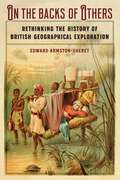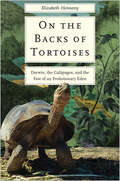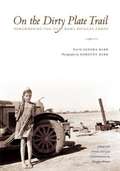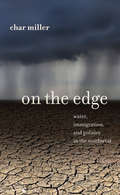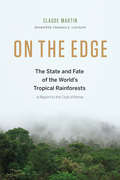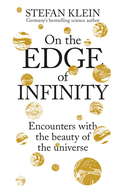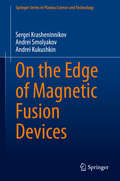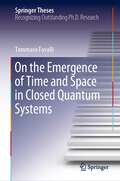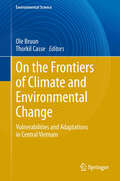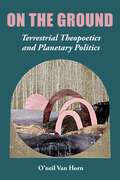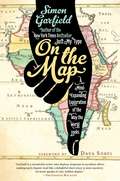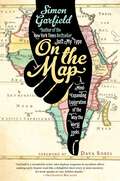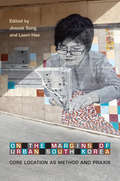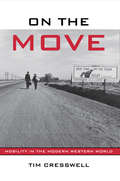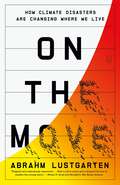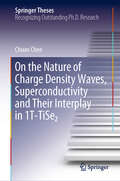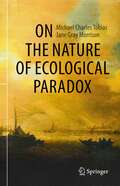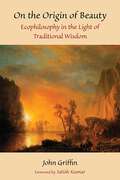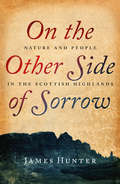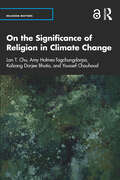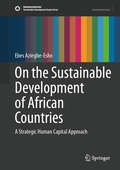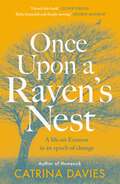- Table View
- List View
On the Backs of Others: Rethinking the History of British Geographical Exploration
by Edward Armston-SheretIn the Victorian and Edwardian eras British explorers sought to become respected geographers and popular public figures, downplaying or reframing their reliance on others for survival. Far from being solitary heroes, these explorers were in reality dependent on the bodies, senses, curiosity, and labor of subaltern people and animals. In On the Backs of Others Edward Armston-Sheret offers new perspectives on British exploration in this era by focusing on the contributions of the people and animals, ordinarily written out of the mainstream histories, who made these journeys possible. He explores several well-known case studies of enduring popular and academic interest, such as Richard Francis Burton and John Hanning Speke&’s Nile expeditions (1856–59 and 1860–63); Isabella Bird&’s travels in North America, Persia, and East Asia (1872–c. 1900); and Captain Robert Falcon Scott&’s two Antarctic expeditions (1901–4 and 1911–13). Armston-Sheret argues that numerous previously ignored stories show the work and agency of subaltern groups. In rethinking the history of exploration On the Backs of Others offers the first book-length study of the relationship between exploration and empire and their legacies within academic geography.
On the Backs of Tortoises: Darwin, the Galapagos, and the Fate of an Evolutionary Eden
by Elizabeth HennessyAn insightful exploration of the iconic Galápagos tortoises, and how their fate is inextricably linked to our own in a rapidly changing world. Finalist for the 2020 E.O. Wilson Literary Science Writing Award, sponsored by PEN America Literary Awards The Galápagos archipelago is often viewed as a last foothold of pristine nature. For sixty years, conservationists have worked to restore this evolutionary Eden after centuries of exploitation at the hands of pirates, whalers, and island settlers. This book tells the story of the islands&’ namesakes—the giant tortoises—as coveted food sources, objects of natural history, and famous icons of conservation and tourism. By doing so, it brings into stark relief the paradoxical, and impossible, goal of conserving species by trying to restore a past state of prehistoric evolution. The tortoises, Elizabeth Hennessy demonstrates, are not prehistoric, but rather microcosms whose stories show how deeply human and nonhuman life are entangled. In a world where evolution is thoroughly shaped by global history, Hennessy puts forward a vision for conservation based on reckoning with the past, rather than trying to erase it. &“Fresh, insightful . . . Hennessy&’s melding of human and natural history makes for thought-provoking reading.&” —Booklist (starred review) &“Gripping . . . well-researched and thought-provoking . . . whether you&’re well-versed in the intricacies of conservation or have only just begun to long for a look at the tortoises yourself. On the Backs of Tortoises is a natural history that asks important questions, and challenges us to think about how best to answer them.&” —Genevieve Valentine, NPR &“Wonderfully interesting, informative, and engaging, as well as scholarly.&” —Janet Browne, author of Charles Darwin: Voyaging and Charles Darwin: The Power of Place
On the Day You Were Born
by Debra Frasier"For Mother Earth, born 4½ billion years ago and Baby Calla, born June 1, 1988 and You who told the monarch butterflies, who told the green turtles, who told the European eel, who told the busy garden warblers, While you waited in darkness, tiny knees curled to chin, the Earth and her creatures with the Sun and the Moon all moved in their places, each ready to greet you the very first moment of the very first day you arrived. ..."
On the Dirty Plate Trail: Remembering the Dust Bowl Refugee Camps
by Sanora BabbThe 1930s exodus of "Okies" dispossessed by repeated droughts and failed crop prices was a relatively brief interlude in the history of migrant agricultural labor. <P><P>Yet it attracted wide attention through the publication of John Steinbeck's The Grapes of Wrath (1939) and the images of Farm Security Administration photographers such as Dorothea Lange and Arthur Rothstein. Ironically, their work risked sublimating the subjects--real people and actual experience--into aesthetic artifacts, icons of suffering, deprivation, and despair. Working for the Farm Security Administration in California's migrant labor camps in 1938-39, Sanora Babb, a young journalist and short story writer, together with her sister Dorothy, a gifted amateur photographer, entered the intimacy of the dispossessed farmers' lives as insiders, evidenced in the immediacy and accuracy of their writings and photos. Born in Oklahoma and raised on a dryland farm, the Babb sisters had unparalleled access to the day-by-day harsh reality of field labor and family life.
On the Edge
by Char MillerOn the Edge grew out of a lifetime spent living and traveling across the American Southwest, from San Antonio to Los Angeles. Char Miller examines this borderland region through a native's eyes and contemplates its considerable conflicts. Internal to the various US states and Mexico's northern tier, there are struggles over water, debates over undocumented immigrants, the criminalizing of the border, and the region's evolution into a no-man's land.The book investigates how we live on this contested land --how we make our place in its oft-arid terrain; an ecosystem that burns easily and floods often and defies our efforts to nestle in its foothills, canyons, and washes.Exploring the challenges in the Southwest of learning how to live within this complex natural system while grasping its historical and environmental frameworks. Understanding these framing devices is critical to reaching the political accommodations necessary to build a more generous society, a more habitable landscape, and a more just community, whatever our documented status or species.
On the Edge
by Char MillerOn the Edge grew out of a lifetime spent living and traveling across the American Southwest, from San Antonio to Los Angeles. Char Miller examines this borderland region through a native's eyes and contemplates its considerable conflicts. Internal to the various US states and Mexico's northern tier, there are struggles over water, debates over undocumented immigrants, the criminalizing of the border, and the region's evolution into a no-man's land.The book investigates how we live on this contested land --how we make our place in its oft-arid terrain; an ecosystem that burns easily and floods often and defies our efforts to nestle in its foothills, canyons, and washes.Exploring the challenges in the Southwest of learning how to live within this complex natural system while grasping its historical and environmental frameworks. Understanding these framing devices is critical to reaching the political accommodations necessary to build a more generous society, a more habitable landscape, and a more just community, whatever our documented status or species.
On the Edge
by Thomas E. Lovejoy Claude MartinIn 1972, The Limits to Growth introduced the idea that world resources are limited. Soon after, people became aware of the threats to the world's rainforests, the biggest terrestrial repositories of biodiversity and essential regulators of global air and water cycles. Since that time, new research and technological advances have greatly increased our knowledge of how rainforests are being affected by changing patterns of resource use. Increasing concern about climate change has made it more important than ever to understand the state of the world's tropical forests.This book provides an up-to-date picture of the health of the world's tropical forests. Claude Martin, an eminent scientist and conservationist, integrates information from remote imaging, ecology, and economics to explain deforestation and forest health throughout the world. He explains how urbanization, an increasingly global economy, and a worldwide demand for biofuels put new pressure on rainforest land. He examines the policies and market forces that have successfully preserved forests in some areas and discusses the economic benefits of protected areas. Using evidence from ice core records and past forest cover patterns, he predicts the most likely effects of climate change.Claude Martin brings his wealth of experience as an ecologist, director of the WWF, and advistor to various conservation organizations to bear on the latest research from around the world. Contributions from eight leading experts provide additional insight.
On the Edge of Infinity: Encounters with the Beauty of the Universe
by Stefan KleinFrom the award-winning, bestselling German science author Stefan Klein An original way into the most thought-provoking scientific theories and ideas, On The Edge of Infinity is the perfect read for those curious about the workings of the universe.*How can a hurricane can reveal the world's unpredictability?How can a greying beard might demonstrate the irreversibility of time?How do the exploits of burglars in New York and London demonstrate how everything can be in two places at once?Employing stories about simple everyday items or occurrences as analogies to illuminate counterintuitive realities behind the visible world, On The Edge of Infinity reveals the astonishing beauty of the universe. This book transforms a simple everyday thing such as a rose blossom, or a day of stormy weather, into a key to understanding the most complex ideas and theories in 21st century physics. Stefan Klein unpicks the complexities and intricacies of physics, from the answered questions to the dark corners of what we have yet to discover, making this an accessible read to those with no previous knowledge of the subject.
On the Edge of Magnetic Fusion Devices (Springer Series in Plasma Science and Technology)
by Sergei Krasheninnikov Andrei Smolyakov Andrei KukushkinThis book reviews the current state of understanding concerning edge plasma, which bridges hot fusion plasma, with a temperature of roughly one million degrees Kelvin with plasma-facing materials, which have melting points of only a few thousand degrees Kelvin. In a fact, edge plasma is one of the keys to solution for harnessing fusion energy in magnetic fusion devices.The physics governing the processes at work in the edge plasma involves classical and anomalous transport of multispecies plasma, neutral gas dynamics, atomic physics effects, radiation transport, plasma-material interactions, and even the transport of plasma species within the plasma-facing materials.The book starts with simple physical models, then moves on to rigorous theoretical considerations and state-of-the-art simulation tools that are capable of capturing the most important features of the edge plasma phenomena. The authors compare the conclusions arising from the theoretical and computational analysis with the available experimental data. They also discuss the remaining gaps in their models and make projections for phenomena related to edge plasma in magnetic fusion reactors.
On the Emergence of Time and Space in Closed Quantum Systems (Springer Theses)
by Tommaso FavalliTime, space and entanglement are the main characters in this book. Their nature is still a great mystery in physics and we study here the possibility that these three phenomena are closely connected, showing how entanglement can be at the basis of the emergence of time and space within closed quantum systems. We revisit and extend the Page and Wootters theory that was originally introduced in order to describe the emergence of time through entanglement between subsystems in a globally static, quantum Universe. In the book, after providing a complete review of the salient aspects of the theory, we establish a connection with recent research on the foundations of statistical mechanics and we provide a new understanding of the thermalization process. Furthermore, we generalize the framework in order describe the spatial degree of freedom and we provide a model of 3+1 dimensional, quantum spacetime emerging from entanglement among different subsystems in a globally "timeless" and "positionless" Universe. Finally, via the Page and Wootters theory, the evolution of quantum clocks within a gravitational field is treated and a time dilation effect is obtained in agreement with the Schwarzschild solution.
On the Frontiers of Climate and Environmental Change
by Ole Bruun Thorkil CasseThis book is intended to fill a gap in climate-change literature by providing a comprehensive regional study and identifying the overall adaptation challenges in a real-life context. The way in which possible climate impacts interact with a range of other challenges in agriculture, forestry, disaster planning, health care, general economic development, and common livelihoods are presented, and it is argued that greater realism and broader vision are needed in order to address the climate challenge. For instance, unsuitable land- use changes in both coastal and highland regions may increase the vulnerability of rural people, many of whom are already living on the fringes. The author(s) also state(s) that, depending on context, it may be pertinent to address short-term and unsustainable resource use, irregularities in local land management, ineffective governance and social inequality, which are all likely to aggravate the impact of external climate and weather. Not least, it is imperative to integrate general environmental management with any climate-change adaptation effort.
On the Ground: Terrestrial Theopoetics and Planetary Politics
by O'neil Van HornA bold, theoretical, and pragmatic book that looks to soil as a symbol for constructive possibilities for hope and planetary political action in the Anthropocene.Climate change is here. Its ravaging effects will upend our interconnected ecosystems, and yet those effects will play out disproportionately among the planet’s nearly 8 billion human inhabitants. On the Ground explores how one might account for the many paradoxical tensions posed by the Anthropocene: tensions between planetarity and particularity, connectivity and contextuality, entanglement and exclusion. Using the philosophical and theological idea of “ground,” Van Horn argues that ground—when read as earth-ground, as soil—offers a symbol for conceiving of the effects of climate change as collective and yet located, as communal and yet differential. In so doing, he offers critical interventions on theorizations of hope and political action amid the crises of climate change.Drawing on soil science, theopoetics, feminist ethics, poststructuralism, process philosophy, and more, On the Ground asks: In the face of global climate catastrophe, how might one theorize this calamitous experience as shared and yet particular, as interconnected and yet contextual? Might there be a way to conceptualize our interconnected experiences without erasing critical constitutive differences, particularly of social and ecological location? How might these conceptual interventions catalyze pluralistic, anti-racist planetary politics amid the Anthropocene? In short, the book addresses these queries: What philosophical and theological concepts can soil create? How might soil inspire and help re-imagine forms of planetary politics in the midst of climate change? On the Ground thus roots us in a robust theoretical symbol in the hopes of producing and proliferating intersectional responses to climate change.
On the Map: A Mind-Expanding Exploration of the Way the World Looks
by Simon GarfieldCartography enthusiasts rejoice: the bestselling author of the Just My Type reveals the fascinating relationship between man and map. Simon Garfield’s Just My Type illuminated the world of fonts and made everyone take a stand on Comic Sans and care about kerning. Now Garfield takes on a subject even dearer to our fanatical human hearts: maps. Imagine a world without maps. How would we travel? Could we own land? What would men and women argue about in cars? Scientists have even suggested that mapping—not language—is what elevated our prehistoric ancestors from ape-dom. Follow the history of maps from the early explorers’ maps and the awe-inspiring medieval Mappa Mundi to Google Maps and the satellite renderings on our smartphones, Garfield explores the unique way that maps relate and realign our history—and reflect the best and worst of what makes us human. Featuring a foreword by Dava Sobel and packed with fascinating tales of cartographic intrigue, outsize personalities, and amusing “pocket maps” on an array of subjects from how to fold a map to the strangest maps on the Internet, On the Map is a rich historical tapestry infused with Garfield’s signature narrative flair. Map-obsessives and everyone who loved Just My Type will be lining up to join Garfield on his audacious journey through time and around the globe.
On the Map: A Mind-Expanding Exploration of the Way the World Looks
by Simon GarfieldCartography enthusiasts rejoice: the bestselling author of Just My Type reveals the fascinating relationship between man and map.Simon Garfield’s Just My Type illuminated the world of fonts and made everyone take a stand on Comic Sans and care about kerning. Now Garfield takes on a subject even dearer to our fanatical human hearts: maps.Imagine a world without maps. How would we travel? Could we own land? What would men and women argue about in cars? Scientists have even suggested that mapping—not language—is what elevated our prehistoric ancestors from ape-dom. Follow the history of maps from the early explorers’ maps and the awe-inspiring medieval Mappa Mundi to Google Maps and the satellite renderings on our smartphones, Garfield explores the unique way that maps relate and realign our history—and reflect the best and worst of what makes us human.Featuring a foreword by Dava Sobel and packed with fascinating tales of cartographic intrigue, outsize personalities, and amusing “pocket maps” on an array of subjects from how to fold a map to the strangest maps on the Internet, On the Map is a rich historical tapestry infused with Garfield’s signature narrative flair. Map-obsessives and everyone who loved Just My Type will be lining up to join Garfield on his audacious journey through time and around the globe.
On the Margins of Urban South Korea: Core Location as Method and Praxis
This book provides a rich and illuminating account of the peripheries of urban, regional, and transnational development in South Korea. Engaging with the ideas of "core location," a term coined by Baik Young-seo, and "Asia as method," a concept with a century-old intellectual lineage in East Asia, each chapter in the volume discusses the ways in which a place can be studied in anthe increasingly globalizeding world. Examining cases set in Chinatown, the Jeju English Eeducation Ccity, rural areas of migrant wives, greenbelts, anti-poverty and community activist sites, places of community activism, rural areas home to large numbers of migrant women, and Korea’s Chinatowns, greenbelts, and textile factories in Korea, each chapterthe collection develops a relational understanding of a place, in which a place is analyzed as a constellation of local and global forces and processes that interact and contradict in particular ways. Each chapter also explores multiple modes of urban marginality, and discusses how understanding them shapes the methods of academic praxis for social justice causes and decolonialized scholarship. This book is the outcome of several years of interdisciplinary collaborations and dialogues among scholars based in geography, architecture, anthropology, and urban politics.
On the Move: Mobility in the Modern Western World
by Timothy CresswellOn the Move presents a rich history of one of the key concepts of modern life: mobility. Increasing mobility has been a constant throughout the modern era, evident in mass car ownership, plane travel, and the rise of the Internet. Typically, people have equated increasing mobility with increasing freedom. However, as Cresswell shows, while mobility has certainly increased in modern times, attempts to control and restrict mobility are just as characteristic of modernity. Through a series of fascinating historical episodes Cresswell shows how mobility and its regulation have been central to the experience of modernity.
On the Move: The Overheating Earth and the Uprooting of America
by Abrahm LustgartenA New York Times Book Review Editors’ ChoiceA Finalist for the Helen Bernstein Book Award“On the Move explains how we got here and where we’re headed. It’s crucial guide to the world we are creating.” —Elizabeth Kolbert, author of Under a White Sky and The Sixth ExtinctionA vivid, journalistic account of how climate change will make American life as we know it unfeasible.Humanity is on the precipice of a great climate migration, and Americans will not be spared. Tens of millions of people are likely to be driven from the places they call home. Poorer communities will be left behind, while growth will surge in the cities and regions most attractive to climate refugees. America will be changed utterly.Abrahm Lustgarten’s On the Move is the definitive account of what this massive population shift might look like. As he shows, the United States will be rendered unrecognizable by four unstoppable forces: wildfires in the West; frequent flooding in coastal regions; extreme heat and humidity in the South; and droughts that will make farming all but impossible across much of the nation.Reporting from the front lines of climate migration, Lustgarten explains how a pattern of shortsighted policies encouraged millions to settle in vulnerable parts of the country, and introduces us to homeowners in California, insurance customers in Florida, and ranchers in Colorado who are being forced to make the agonizing choice of when, not whether, to leave. Employing the most current climate data and predictive models, he shows how America’s population will be squeezed northward into a shrinking triangle of land stretching from Tennessee to Maine to the Great Lakes. The places many of us now call home are at risk, and On the Move reveals how we’ll deal with the consequences.
On the Nature of Charge Density Waves, Superconductivity and Their Interplay in 1T-TiSe₂ (Springer Theses)
by Chuan ChenThis thesis presents analytical theoretical studies on the interplay between charge density waves (CDW) and superconductivity (SC) in the actively studied transition-metal dichalcogenide 1T-TiSe2. It begins by reapproaching a years-long debate over the nature of the phase transition to the commensurate CDW (CCDW) state and the role played by the intrinsic tendency towards excitonic condensation in this system. A Ginzburg-Landau phenomenological theory was subsequently developed to understand the experimentally observed transition from commensurate to incommensurate CDW (ICDW) order with doping or pressure, and the emergence of a superconducting dome that coexists with ICDW. Finally, to characterize microscopically the effects of the interplay between CDW and SC, the spectrum of CDW fluctuations beyond mean-field was studied in detail. In the aggregate, the work reported here provides an encompassing understanding of what are possibly key microscopic underpinnings of the CDW and SC physics in TiSe2.
On the Nature of Ecological Paradox
by Michael Charles Tobias Jane Gray MorrisonThis work is a large, powerfully illustrated interdisciplinary natural sciences volume, the first of its kind to examine the critically important nature of ecological paradox, through an abundance of lenses: the biological sciences, taxonomy, archaeology, geopolitical history, comparative ethics, literature, philosophy, the history of science, human geography, population ecology, epistemology, anthropology, demographics, and futurism. The ecological paradox suggests that the human biological–and from an insular perspective, successful–struggle to exist has come at the price of isolating H. sapiens from life-sustaining ecosystem services, and far too much of the biodiversity with which we find ourselves at crisis-level odds. It is a paradox dating back thousands of years, implicating millennia of human machinations that have been utterly ruinous to biological baselines. Those metrics are examined from numerous multidisciplinary approaches in this thoroughly original work, which aids readers, particularly natural history students, who aspire to grasp the far-reaching dimensions of the Anthropocene, as it affects every facet of human experience, past, present and future, and the rest of planetary sentience.With a Preface by Dr. Gerald Wayne Clough, former Secretary of the Smithsonian Institution and President Emeritus of the Georgia Institute of Technology. Foreword by Robert Gillespie, President of the non-profit, Population Communication.
On the Origin of Beauty: Ecophilosophy in the Light of Traditional Wisdom
by John GriffinIn the light of the looming ecological crisis facing the world today, much of the stunning beauty of the natural world is being lost forever. On the Origin of Beauty seeks to confront this crisis through a philosophical enquiry into our perception of natural beauty. Through discussions of numerous fields including the philosophy of science, environmental ethics, rationalism, and Eastern and Western religion, Griffin asserts that Beauty itself may be the catalyst needed to save the globe from destruction.
On the Other Side of Sorrow: Nature and People in the Scottish Highlands
by James Hunter&“An extraordinary intellectual voyage&” through Gaelic environmental awareness, centuries ahead of its time, and its value today (The Herald). Caring for the environment, developing rural communities, and ensuring the survival of minority cultures are all laudable objectives, but they can conflict, and nowhere more so than the Scottish Highlands. As environmentalists strive to preserve the scenery and wildlife of the Highlands, the people who belong there, and who have their own claims on the landscape, question this new threat to their culture, which dates back thousands of years. In this sensitive, thought-provoking book, James Hunter probes deep into this culture to examine the dispute between Highlanders, who developed a strong environmental awareness a thousand years before other Europeans, and conservationists, whose thinking owes much to the romantic ideals of the nineteenth century. More than that, he also suggests a new way of dealing with the problem, advocating drastic land-use changes and the repopulation of empty glens—an approach that has worldwide implications. &“A very thoughtful piece of advocacy.&” —The Scotsman
On the Significance of Religion in Climate Change (Religion Matters)
by Lan T. Chu Amy Holmes-Tagchungdarpa Kalzang Bhutia Youssef ChouhoudThis book explores the role of religion in discussions about climate change and, particularly, the development of responses to climate change on global, state, institutional, and local levels. It considers examples of the ways that different religious traditions, including Indigenous, Muslim, Buddhist, and Christian communities, have responded to the different effects of climate change by using different methodological approaches, including political science and international relations (e.g. public opinion polls and constructivism); religious studies scholarship on climate change, including an overview of religion and ecology as a subdiscipline in religious studies; and environmental humanities approaches.This volume interrogates the diverse ways religion both acts and is acted upon by different actors, including institutions and nation states, in response to climate change. Within single traditions, different actors advocate for planetary care and concern, while their co-religionists may remain passive or deny climate change as a phenomenon.This book hopes to complicate and unravel the complexities of how different religions approach climate change and recommends that religions are taken seriously in the development of climate change mitigation strategies at different scales.The Open Access version of this book, available at http://www.taylorfrancis.com, has been made available under a Creative Commons Attribution-Non Commercial-No Derivatives (CC BY-NC-ND) 4.0 license
On the Sustainable Development of African Countries: A Strategic Human Capital Approach (Sustainable Development Goals Series)
by Ebes Aziegbe-EshoDespite Africa’s vast and diverse natural resources, the developmental challenges plaguing the continent still remain. Indeed, a common factor that seems to bind all African countries together is developmental problems and challenges. From North Africa to Southern Africa, across West Africa through to Central and East Africa, African countries, especially those in Sub-Saharan Africa, are faced with the same or similar developmental challenges. Many reasons have been offered for Africa’s developmental challenges. Amongst developmental economists, the reasons range from geographical, historical, cultural, and tribal factors, to institutional factors. The unfavourable geographical landscape, its colonial and other peculiar histories, the huge diversity in culture and tribe that seem to hinder efforts at unity, and lack of good governance and the institutions of quality governance, have all been given as reasons for the inability of the continent to make good developmental progress. This book offers a strategic human capital approach as a pathway to the sustainable development of African countries. The book synthesizes different knowledge domains on human capital, and presents ways on how human capital can be strategically developed and accumulated by African countries for sustainable development. The book highlights how the continent’s growing youthful population can be strategically harnessed into human capital for sustainable development. Unlike other books on human capital and Africa’s development that rely on a single disciplinary perspective, usually from economics, this book takes a multi-disciplinary and inter-disciplinary approach. The book draws from theories and studies of human capital in economics, the originating discipline of the concept, strategic management, entrepreneurship, and Strategic Human Resources Management. Thus, it is able to present the discuss and recommendations from a holistic integration of the concept of human capital. The book also presents case studies of three countries, Singapore, Finland, and Canada, that have successfully made strategic use of human capital in their national development in different ways; another unique feature of the book. Lessons on national human capital development are drawn from each case study. Another unique feature of the book is its integration of the various global human capital indices available for a comprehensive understanding of the indices, their components, and utility for countries. Finally, the book is replete with many generic and specific recommendations on how human capital can be developed by various stake holders in Africa. A whole chapter is dedicated to generic strategic approaches to human capital development that can be adopted by African countries; and indeed, by all countries as they can be applied by other countries. The generic approaches are cumulatively drawn from resource-based theory (RBT), transaction cost economics, and human capital theory. Another chapter is also dedicated to more specific recommendations on human capital development and accumulation.
Once Upon a Raven's Nest: a life on Exmoor in an epoch of change
by Catrina Davies'This is a rich, beautiful and deeply moving book' GEORGE MONBIOT'I loved this book' CLOVER STROUDOnce Upon a Raven's Nest is the story of a working class man, one Thomas Hedley of Exmoor, and of the planet during the period of its great acceleration towards the current climate emergency.Born in 1955 to a poor family in Devon Thomas refused to conform. His fierce independence, recklessness and contrariness led not only to scrapes and self-inflicted dangers but to a life enriched by the love of women. Catrina Davies came to know him in his last years and has given his life and times in his own words, creating a rich, pungent language in a knowing, poetic and poignant voice.We learn of his accumulation of engines, tools and guns, the complexity of his connection to nature, the animals he loved and his desire to hunt them. He recounts the terrible consequences of his fatal attraction to risk and machinery which led to his being paralysed for the last years of his life, confined to a wheelchair, hopelessly dependent but still watching, noticing, recording, loving the world.The narrative is interwoven with a sequence of factual entries that chart the impending climate catastrophe and the consequences of our collective choices to ignore the warning of an environment on the verge of collapse.Once Upon A Raven's Nest is an unforgettable history of a life that is almost lost and an account of the destruction man has wrought on the earth in the time that Hedley worked the land.'Stunning. Urgent. Unforgettable' TANYA SHADRICK'This has the unmistakable smell of a classic' CHARLES FOSTER
Once Within Borders
by Charles S. MaierAt a time when the technologies of globalization are eroding barriers to communication, transportation, and trade, Charles Maier explores the fitful evolution of territories--politically bounded regions whose borders define the jurisdiction of laws and the movement of peoples--as a worldwide practice of human societies.
